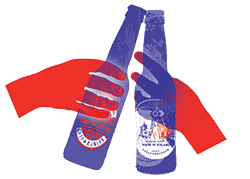Here’s to the land of the midnight bar

Roula Khalaf, Editor of the FT, selects her favourite stories in this weekly newsletter.
Last week, as the midnight sun blazed out across the Arctic region, I travelled to Iceland to take part in a conference about post-crisis global finance. Unsurprisingly, the event yielded plenty of solemn debate about weighty issues such as capital controls, debt restructuring and bank regulation (on which I shall write anon). But for my money, the most memorable economic lesson came from an unexpected source: beer.
A decade ago, my Icelandic acquaintances explained – as we roamed the uncannily bright Reykjavík streets at midnight – almost all the beer on sale in Iceland was made by foreign brands. No surprises there: beer production and consumption were banned during most of the 20th century, because the government was concerned about alcohol abuse. Even when beer prohibition ended in 1989, the Icelandic population initially bought their beer from places such as Denmark. Then, when Iceland became sucked into the crazy global credit bubble in the middle of the past decade, Icelanders became so rich (at least on paper) that they started importing ultra-high-priced drinks from all over the world. The midnight bar trade in Reykjavík became a potent symbol of financial globalisation – much like the Icelandic banks themselves, which expanded at a breakneck speed, assuming debts that were 11 times larger than the economy.
These days, the mood in those bars has changed. When the 2008 financial crisis struck, Iceland plunged into a devastating downward spiral. Ninety per cent of its banking system collapsed, one in 10 was unemployed, the local currency lost half its value – and the government imposed capital controls. That made it very hard for anyone to purchase imported beer or wine any more (or almost anything else).
But Icelanders did not stop drinking or resort to moonshine. Instead, the financial crisis gave birth to a microbrewery revolution. First a couple of nascent local breweries ramped up their production to provide a good, domestic beer that the population could afford. Other entrepreneurs followed suit, and these days half-a-dozen microbreweries serve a population of just 320,000. If you walk into a bar in Reykjavík today, you can still purchase well-known global brands. Danish imports account for about 30 per cent of the market (the population drinks some 63 litres per person each year, according to Carlsberg, the leading brand). But you can also buy a Kaldi (produced by the Bruggsmiðjan brewery in the north of Iceland) or Skjálfti (produced by the Ölvisholt operation on the south coast), along with offerings from newer microbreweries such as Einstök, Borg, Skagafjörður and Steðji.

Oddly enough, today these domestic brands are not much cheaper than imports. Meanwhile, the government is now muttering about lifting capital controls. But those Icelandic beers have become so popular – and such a point of national pride – that more microbreweries are planned. And their offerings taste dramatically better than the mass-produced imports; for my part, I particularly like Skjálfti.
On one level, this is a tiny example of Iceland’s famously resilient spirit; since 2008 the country’s leadership has been scrambling to reinvent itself in numerous ways. But it raises some bigger questions too. A decade ago, it was widely presumed in the west that the path of globalisation could move in only one direction; the world seemed to be on a trajectory to become ever-more interconnected, delivering (it was thought) ever-higher levels of growth.
But since the financial crisis of 2008, that path has become muddied – and muddled. There has not been much direct trade protectionism as such, unlike the 1930s. But the level of global financial integration has dropped to a surprising degree, as a fascinating report from McKinsey Global Institute, the consultancy’s research arm, recently pointed out.
…
A mood of localisation, not globalisation, has crept into the debate in unexpected ways in many different corners of the world. One ugly manifestation of this has been an upswing in nationalist politics in parts of Europe. But another, more positive, consequence is that some communities have rediscovered the value of local products or community-based economies, either out of necessity or a sense of local pride. Iceland is a case in point but similar tales of localisation – and local innovation – can be seen in other disaster-hit places ranging from Argentina to Greece to recession-scarred Detroit.
This does not mean that places such as Iceland are shutting their doors on the world; on the contrary, Iceland thinks that the key to rebuilding its economy is to be a global tourist, energy and IT hub. But these days, their attitude towards globalisation is warier and wiser. And some entrepreneurial Icelandic folk now want to take the next step and start exporting those unpronounceable beers to places such as Denmark or the UK. If nothing else, it shows that history can sometimes move in unexpected ways – even (or especially) in a bar.
Illustration by Shonagh Rae
Comments